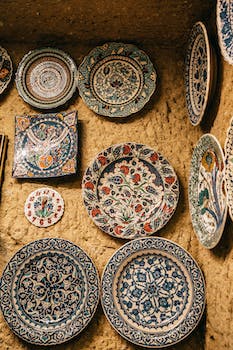The Middle East design market presents a unique blend of opportunities and challenges. With its rich cultural heritage, rapid urbanization, and growing consumer base, the region offers immense potential for designers and design firms. However, navigating the market requires an understanding of the region’s cultural nuances, economic dynamics, and competitive landscape. In this introduction, we will explore the opportunities and challenges that designers face in the Middle East design market.
Emerging Trends in the Middle East Design Market
The Middle East design market is experiencing a period of rapid growth and transformation. As the region continues to develop and diversify its economy, there are numerous opportunities for designers and businesses to thrive. However, along with these opportunities come a unique set of challenges that must be navigated in order to succeed in this dynamic market.
One of the emerging trends in the Middle East design market is the increasing demand for sustainable and environmentally-friendly design solutions. As the region grapples with the effects of climate change and strives to reduce its carbon footprint, there is a growing awareness of the need for sustainable design practices. This presents an opportunity for designers who specialize in green design to capitalize on this demand and offer innovative solutions that meet the needs of both clients and the environment.
Another trend that is shaping the Middle East design market is the rise of digital technology. With the proliferation of smartphones and the increasing accessibility of the internet, consumers in the region are becoming more tech-savvy and demanding digital solutions. This has led to a surge in demand for digital design services, such as website design, app development, and user experience design. Designers who are able to adapt to this digital landscape and offer cutting-edge solutions will find themselves in high demand.
In addition to these emerging trends, there are also several challenges that designers and businesses face in the Middle East design market. One of the main challenges is the cultural diversity of the region. The Middle East is home to a wide range of cultures, each with its own unique design preferences and aesthetic sensibilities. Designers must be able to navigate this cultural diversity and tailor their designs to suit the specific needs and tastes of their clients.
Another challenge is the intense competition in the market. As the Middle East design market continues to grow, more and more designers and businesses are entering the industry, making it increasingly competitive. Designers must find ways to differentiate themselves from their competitors and offer unique value propositions to attract clients. This may involve developing a niche specialization, offering exceptional customer service, or leveraging technology to deliver innovative design solutions.
Furthermore, designers must also be aware of the political and economic landscape of the region. The Middle East is known for its geopolitical tensions and economic volatility, which can have a significant impact on the design market. Designers must be able to adapt to these changing circumstances and be prepared to navigate any potential disruptions that may arise.
In conclusion, the Middle East design market offers numerous opportunities for designers and businesses to thrive. However, it also presents a unique set of challenges that must be navigated in order to succeed. By staying abreast of emerging trends, such as sustainable design and digital technology, and being aware of the cultural, competitive, and geopolitical factors at play, designers can position themselves for success in this dynamic market. With the right strategies and a keen understanding of the market, designers can capitalize on the opportunities and overcome the challenges to achieve long-term success in the Middle East design market.
Exploring the Potential of the Middle East Design Market
The Middle East design market is a rapidly growing industry that presents both opportunities and challenges for businesses. With a population of over 400 million people and a strong economy, the region offers a vast potential for design companies to expand their reach and tap into new markets. However, navigating the Middle East design market requires a deep understanding of the cultural nuances and business practices unique to the region.
One of the key opportunities in the Middle East design market is the increasing demand for luxury and high-end products. The region is home to a growing number of affluent individuals who are willing to invest in premium design solutions for their homes, offices, and public spaces. This presents a lucrative market for design companies that can cater to the tastes and preferences of this discerning clientele.
Another opportunity lies in the rapid urbanization and infrastructure development taking place in the Middle East. As countries in the region continue to invest in building modern cities and expanding their transportation networks, there is a growing need for innovative design solutions. From architectural design to urban planning, there is a wide range of opportunities for design companies to contribute to the development of the region.
However, entering the Middle East design market also comes with its fair share of challenges. One of the main challenges is the cultural differences and preferences that exist across the region. Each country in the Middle East has its own unique cultural heritage and design aesthetic, which must be taken into consideration when developing products or services. Understanding and respecting these cultural nuances is crucial for success in the market.
Another challenge is the competitive landscape of the Middle East design market. Many international design companies have already established a presence in the region, making it difficult for new entrants to gain a foothold. Building strong relationships with local partners and clients is essential for overcoming this challenge and establishing a strong market position.
Furthermore, the Middle East design market is also subject to geopolitical and economic uncertainties. Political instability and economic fluctuations can impact consumer spending and investment decisions, which in turn affects the demand for design services. Design companies operating in the region must be prepared to navigate these uncertainties and adapt their strategies accordingly.
Despite these challenges, the Middle East design market offers immense potential for growth and success. By understanding the unique cultural and business landscape of the region, design companies can position themselves as trusted partners and providers of innovative solutions. Building strong relationships with local stakeholders and investing in market research and intelligence are key to capitalizing on the opportunities available.
Challenges Faced by Designers in the Middle East Market
The Middle East design market is a rapidly growing industry that offers numerous opportunities for designers. However, like any market, it also presents its fair share of challenges. In this section, we will explore some of the key challenges faced by designers in the Middle East market.
One of the primary challenges is the cultural diversity of the region. The Middle East is home to a wide range of cultures, each with its own unique design preferences and aesthetic sensibilities. Designers must navigate this diversity and find ways to create designs that appeal to a broad audience. This requires a deep understanding of the cultural nuances and an ability to adapt their designs accordingly.
Another challenge is the language barrier. While English is widely spoken in many parts of the Middle East, there are still significant language differences across the region. Designers must be able to communicate effectively with clients and stakeholders who may not speak English fluently. This can be particularly challenging when it comes to conveying complex design concepts and ideas. Designers must find ways to bridge this language gap and ensure that their designs are understood and appreciated by all.
The Middle East market is also known for its strong emphasis on tradition and heritage. Many clients in the region have a deep attachment to their cultural heritage and expect designs that reflect and celebrate their traditions. This can be a challenge for designers who are used to working in more contemporary and global design styles. They must find ways to incorporate traditional elements into their designs while still maintaining a modern and innovative aesthetic.
Another challenge faced by designers in the Middle East market is the limited availability of resources and materials. While the region is known for its wealth, there are still constraints when it comes to accessing high-quality materials and resources. Designers must be resourceful and find creative solutions to work within these limitations. This may involve sourcing materials from other regions or finding local alternatives that can achieve the desired design outcomes.
Additionally, the Middle East market is highly competitive. With the rapid growth of the design industry in the region, there is an influx of designers from around the world vying for the same opportunities. This means that designers must constantly stay ahead of the curve and offer unique and innovative designs to stand out from the competition. They must also build strong networks and relationships with clients and stakeholders to secure projects and maintain a steady stream of work.
In conclusion, while the Middle East design market offers numerous opportunities, it also presents its fair share of challenges. Designers must navigate the cultural diversity, language barriers, and traditional expectations of clients. They must also find creative solutions to work within limited resources and compete in a highly competitive market. Despite these challenges, the Middle East market is a vibrant and exciting industry that rewards designers who are able to overcome these obstacles and deliver exceptional designs.
Opportunities for Growth in the Middle East Design Industry
The Middle East design market is a rapidly growing industry that presents numerous opportunities for businesses and professionals in the field. With a booming economy and a growing population, the region is witnessing a surge in demand for innovative and aesthetically pleasing designs across various sectors. This article will explore the opportunities for growth in the Middle East design industry and the challenges that businesses may face in this dynamic market.
One of the key opportunities in the Middle East design market is the construction and real estate sector. The region is experiencing a construction boom, with numerous infrastructure projects and urban developments underway. This has created a high demand for architectural and interior design services. From designing luxurious hotels and resorts to creating modern office spaces and residential complexes, there is a wide range of opportunities for design firms and professionals to showcase their expertise.
Another promising sector in the Middle East design market is retail and hospitality. The region is known for its extravagant shopping malls and luxury hotels, which require innovative and captivating designs to attract customers. Retailers are constantly seeking unique and immersive experiences for their customers, and this presents a great opportunity for designers to create visually stunning and functional spaces. Similarly, the hospitality industry is always in need of fresh and appealing designs to provide guests with a memorable stay.
The Middle East design market also offers opportunities in the healthcare sector. With an increasing focus on healthcare infrastructure and services, there is a growing demand for well-designed hospitals, clinics, and medical facilities. Designers who specialize in healthcare design can play a crucial role in creating spaces that are not only aesthetically pleasing but also functional and efficient, ensuring the comfort and well-being of patients and healthcare professionals.
However, along with these opportunities, there are also challenges that businesses may face in the Middle East design market. One of the main challenges is the cultural and regulatory differences. Each country in the region has its own cultural norms and design preferences, which may differ significantly from Western design principles. It is essential for businesses to understand and adapt to these cultural nuances to effectively cater to the local market.
Another challenge is the intense competition in the industry. As the Middle East design market continues to grow, more and more design firms are entering the market, making it increasingly competitive. To stand out from the crowd, businesses need to offer unique and innovative designs, provide exceptional customer service, and build strong relationships with clients and partners.
Furthermore, the Middle East design market is also susceptible to economic fluctuations. The region’s economy is heavily reliant on oil and gas, and any fluctuations in oil prices can have a significant impact on the design industry. Businesses need to be prepared to navigate through economic uncertainties and adapt their strategies accordingly.
Strategies for Success in the Middle East Design Market
The Middle East design market presents both opportunities and challenges for businesses looking to succeed in this region. With its rapidly growing economy and increasing demand for innovative and high-quality design solutions, the Middle East offers a promising market for design firms. However, navigating the cultural and business landscape of the region can be complex and requires careful planning and strategy.
One of the key strategies for success in the Middle East design market is understanding the local culture and customs. The Middle East is a diverse region with a rich cultural heritage, and it is important for businesses to respect and appreciate these traditions. Building relationships based on trust and mutual respect is crucial in this market, and taking the time to understand and adapt to local customs can go a long way in establishing a strong presence.
Another important aspect of succeeding in the Middle East design market is building a strong network of contacts and partnerships. Networking is highly valued in this region, and having the right connections can open doors to new opportunities. Attending industry events, trade shows, and conferences can help businesses meet potential clients and collaborators, and it is important to actively engage in networking activities to expand one’s reach in the market.
In addition to networking, businesses should also invest in marketing and branding efforts to stand out in the competitive Middle East design market. Developing a strong brand identity and showcasing a portfolio of successful projects can help build credibility and attract potential clients. It is important to tailor marketing strategies to the local market, taking into consideration cultural sensitivities and preferences.
Furthermore, businesses should be prepared to adapt their design solutions to meet the specific needs and preferences of the Middle East market. The region has its own unique design aesthetic, influenced by its rich history and cultural heritage. Understanding and incorporating these elements into design projects can help businesses resonate with local clients and differentiate themselves from competitors.
While the Middle East design market offers numerous opportunities, it also presents challenges that businesses need to be aware of. One of the main challenges is the highly competitive nature of the market. Many international design firms are vying for projects in the region, and local firms are also growing in prominence. To succeed, businesses need to differentiate themselves by offering unique and innovative design solutions that meet the specific needs of clients.
Another challenge is the bureaucratic and regulatory environment in the Middle East. Each country has its own set of rules and regulations governing the design industry, and navigating these can be time-consuming and complex. It is important for businesses to familiarize themselves with the local laws and regulations and ensure compliance to avoid any legal issues.
Lastly, businesses should be prepared for the cultural and language barriers that may arise when working in the Middle East. English is widely spoken in business settings, but it is still important to have a basic understanding of Arabic and the local culture to facilitate communication and build relationships.
In conclusion, the Middle East design market offers both opportunities and challenges for businesses. By understanding the local culture, building a strong network, investing in marketing and branding, adapting design solutions to meet local preferences, and navigating the bureaucratic and regulatory environment, businesses can position themselves for success in this dynamic and growing market.



